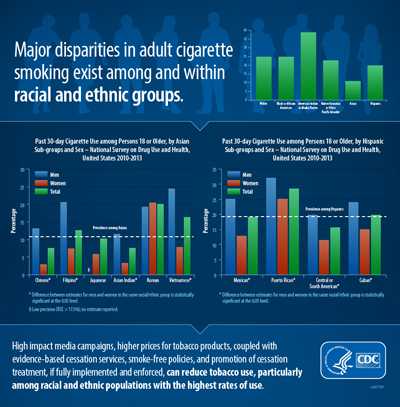Some racial, ethnic groups continue smoking cigarettes at higher rates
Substantial disparities found among American Indians/Alaska Natives, Korean and Puerto Rican Americans
This website is archived for historical purposes and is no longer being maintained or updated.
Press Release
Embargoed Until: Thursday, August 4, 2016, 1:00 p.m. ET
Contact: Media Relations
(404) 639-3286

Major disparities in adult cigarette smoking exist among and within racial and ethnic groups.
Entire infographic
Despite a significant decline in overall adult cigarette smoking since 1964, disparities in cigarette smoking remain among racial and ethnic population groups, according to a new study from the Centers for Disease Control and Prevention (CDC) published in today’s Morbidity and Mortality Weekly Report (MMWR).
For example, current (past 30-day) cigarette smoking during 2010-2013 was lower among Asians overall (10.9 percent) compared with Whites (24.9 percent). But among Asian sub-groups, the prevalence of current cigarette smoking ranged from 7.6 percent among Chinese and Asian Indians to 20.0 percent among Korean Americans. The American Indian/Alaska Native population had the highest prevalence of cigarette smoking at 38.9 percent. The findings in this study show the importance of identifying higher rates of tobacco use across and within racial/ethnic population groups to better understand and address differences in tobacco use among U.S. adults.
Larger sample size for racial/ethnic subgroups
Estimates of cigarette smoking prevalence are usually presented in aggregate for racial or ethnic populations, such as Asian or Hispanic, because sample sizes are too small to provide estimates among racial/ethnic subgroups within these populations. To get a large enough sample size for this study, researchers aggregated data from the National Survey on Drug Use and Health collected between 2002-2005 and 2010-2013 to assess cigarette-smoking prevalence among 6 racial and ethnic population groups and 10 select subgroups in the United States.
“Even though the overall cigarette-smoking rate is declining, disparities remain among racial and ethnic groups and within subgroups,” said Bridgette Garrett, Ph.D., associate director for health equity in the CDC’s Office on Smoking and Health. “Looking beyond broad racial and ethnic population categories can help better focus the strategies that we know work to reduce tobacco use among sub-groups with higher rates of use.”
Additional results from the study include:
- Among Whites, current cigarette smoking prevalence was 27.7 percent in 2002-2005 and 24.9 percent in 2010-2013.
- Among Blacks, current cigarette smoking prevalence was 27.6 percent in 2002-2005 and 24.9 percent in 2010-2013.
- Among American Indians/Alaska Natives, current cigarette smoking prevalence was 37.1 percent in 2002-2005 and 38.9 percent in 2010-2013.
- Among Native Hawaiian or Other Pacific Islanders, current cigarette smoking prevalence was 31.4 percent in 2002-2005 and 22.8 percent in 2010-2013.
Among Asians, the current cigarette smoking prevalence was 14.5 percent in 2002-2005 and 10.9 percent in 2010-2013. Within that group were Chinese (7.6 percent in 2010-2013), Asian Indian (7.6 percent in 2010-2013), Japanese (10.2 percent in 2010-2013), Filipino (12.6 percent in 2010-2013), Vietnamese (16.3 percent in 2010-2013), and Korean (20.0 percent in 2010-2013).
Among Hispanics, current cigarette smoking prevalence was 23.9 percent in 2002-2005 and 19.9 percent in 2010-2013. Within that group were Central or South American (15.6 percent in 2010-2013), Mexican (19.1 percent in 2010-2013), Cuban (19.8 percent in 2010-2013), and Puerto Rican (28.5 percent in 2010-2013).
“We know smoke-free policies, hard-hitting media campaigns, higher prices for tobacco products, and promotion of cessation treatment in clinical settings are proven to reduce tobacco product use,” said Corinne Graffunder, Dr.P.H., director of CDC’s Office on Smoking and Health. “If fully implemented and enforced, these strategies could help reduce tobacco use, particularly among racial and ethnic populations with higher rates of use.”
Tobacco use is the leading cause of preventable disease and death in the United States, responsible for more than 480,000 premature deaths annually. And for each death, there are about 30 Americans suffering from a tobacco-related disease. Smokers can get free help quitting by calling 1-800-QUIT-NOW, or going online to www.smokefree.gov.
- Page last reviewed: August 4, 2016 (archived document)
- Content source:



 ShareCompartir
ShareCompartir